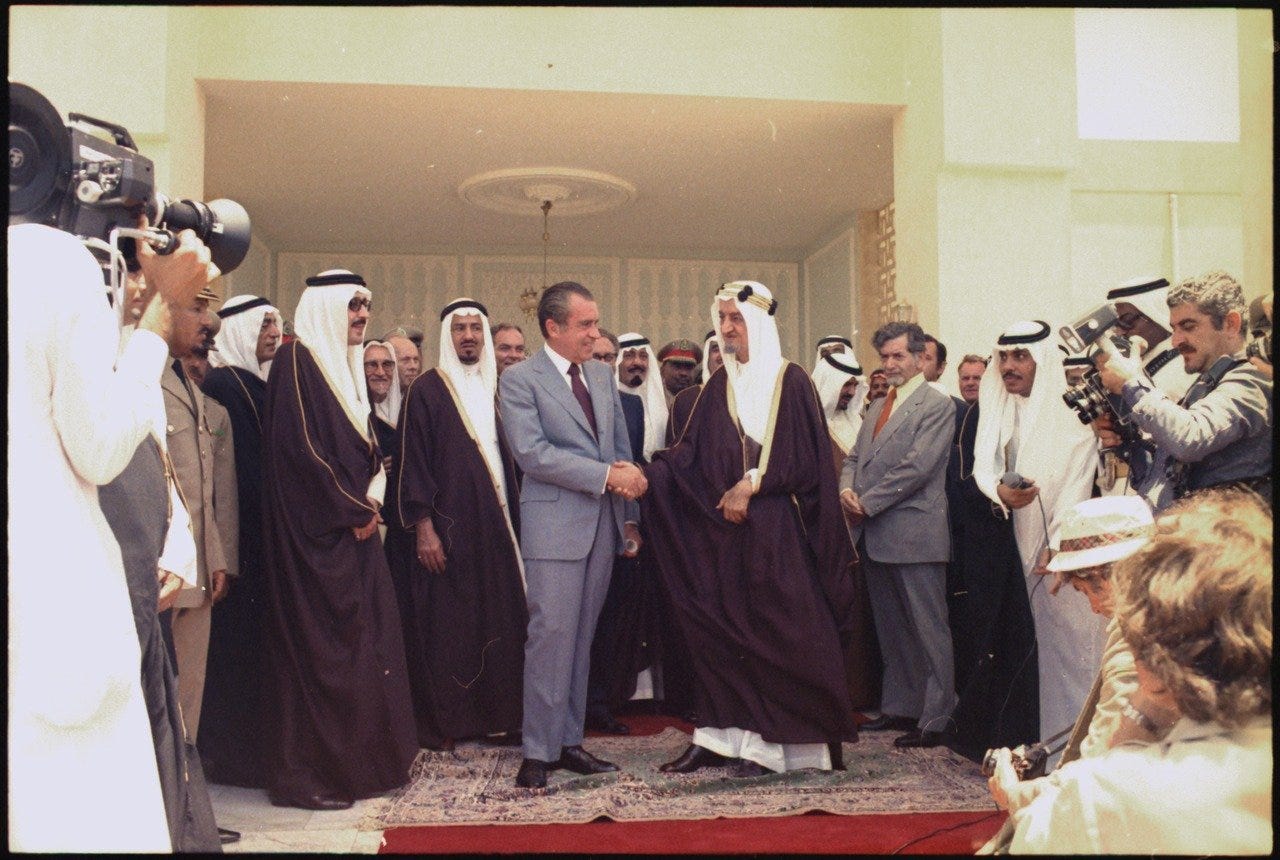50-Year US-Saudi Petrodollar Deal Ends: Looking In Retrospect and Prospect
We explore the background, implications, and future prospects, following the expiration of this historic agreement, which, incidentally, has not found any significant coverage in the mainstream media.

50-Year US-Saudi Petrodollar Deal Ends
The US-Saudi Arabia 50-year Petrodollar agreement, inked half a century ago in 1974 under the leadership of President Nixon and King Faisal of Saudi Arabia, expired on 9th June 2024 as Saudi Arabia declined to renew it. The petrodollar system emerged in the 1970s through this pivotal agreement, fundamentally transforming the global financial landscape. This article explores the background, implications, and future prospects following the expiration of this historic agreement, which, incidentally, has not found any significant coverage in the mainstream media.
Background and Significant Events Leading to the Agreement
Formation of OPEC and the 1973 Oil Shock
The Organization of the Petroleum Exporting Countries (OPEC) was founded in 1960 by Iran, Iraq, Kuwait, Saudi Arabia, and Venezuela to coordinate petroleum policies and stabilize oil markets. However, its role in the oil market remained peripheral at best. By the early 1970s, global oil consumption had more than doubled, outpacing supply, and the U.S. had lost its spare production capacity.
In 1971, the U.S. abandoned the Bretton Woods Accord and the gold standard, leading to dollar instability and depreciated oil revenues for OPEC. In 1973, the Yom Kippur War prompted Arab OPEC members to impose an oil embargo on the U.S. and its allies, causing oil prices to quadruple and leading to global economic turmoil. This crisis set the stage for the 1974 petrodollar agreement between the U.S. and Saudi Arabia.
The Petrodollar Deal
In 1974, the U.S. and Saudi Arabia established two joint commissions on economic cooperation and military needs. Saudi Arabia agreed to price and trade its oil exclusively in U.S. dollars. In return, the U.S. provided economic aid, military protection, and access to U.S. weapons. This deal created the petrodollar system, where oil was globally traded in U.S. dollars.
Implications of the Petrodollar System
Elevation of the U.S. Dollar
The petrodollar system significantly elevated the U.S. dollar's status as the dominant global reserve currency. Continuous demand for U.S. dollars allowed the U.S. to run trade deficits without facing usual negative consequences and enabled borrowing at lower costs to finance budget deficits. Oil-exporting countries accumulated large surpluses of U.S. dollars, reinvesting them in U.S. assets, reinforcing the dollar's dominance.
Geopolitical and Economic Impact
The petrodollar deal was a key factor behind the U.S.'s economic dominance and high standard of living. It forged strong strategic alliances, particularly with Saudi Arabia, and maintained U.S. influence over global oil prices. The arrangement provided the U.S. with economic advantages, such as lower borrowing costs and a robust financial system.
Expiration and Potential Impact
Weakening of the U.S. Dollar's Status
Saudi Arabia's decision not to renew the petrodollar deal allows it to sell oil in other currencies, such as the Chinese yuan, euro, and yen. This represents a major shift away from the petrodollar system and could accelerate the global move away from the U.S. dollar, leading to a more multipolar currency system, not excluding cryptocurrencies.
Impact on the U.S. Economy and Financial Markets
The end of the petrodollar system could result in a decline in global demand for the U.S. dollar, potentially leading to higher inflation, interest rates, and a weaker bond market. The U.S. economy may face challenges in financing deficits cheaply, and the strain on the banking system, national deficit, and federal budget could increase.
Potential Implications for International Oil Prices
The end of the petrodollar system could lead to increased oil price volatility as the market adjusts to a new global financial order. Saudi Arabia's decision to sell oil in other currencies represents a significant shift, potentially reducing global demand for the U.S. dollar. In the near term, OPEC+'s new deal, which allows incremental increases in oil output starting from October 2024, could result in a modest decrease in oil prices and an easing of global inflation. The long-term impact will depend on global economic dynamics, including the rise of alternative currencies, renewable energy growth, new oil-producing nations, and geopolitical shifts.

Implications for India
a.) Opportunities for Trade in Alternative Currencies
With countries like Russia, China, and Saudi Arabia exploring alternatives to the U.S. dollar, India can engage in oil transactions using currencies like the Chinese yuan, Russian ruble, or Indian rupee. This diversification can help mitigate risks associated with dollar dependence.
b.) Reduced Dependence on the U.S. Dollar
A shift away from the petrodollar system could allow India to diversify its foreign exchange reserves, providing greater flexibility in economic policies and trade relationships.
c.) Potential Impact on Oil Prices and Energy Security
The decline of the petrodollar system could lead to increased oil price volatility. As a major oil importer, India will need strategies to manage price fluctuations and ensure energy security.
d.) Balancing Relationships with Major Powers
India must balance its relationships with major powers, such as the U.S., China, Russia, and Saudi Arabia, in the evolving global financial system. Strategic decisions regarding oil trade and currency usage will impact India's geopolitical alignments and economic partnerships.
e.) Participation in Alternative Financial Frameworks
India's involvement in BRICS and other groupings could help shape alternative financial frameworks. Active participation in such initiatives can position India as a key player in a more decentralized global monetary system.
Summing Up and Looking Forward
The expiration of the 50-year petrodollar agreement marks a significant turning point with far-reaching implications for the U.S. dollar, the global financial system, and geopolitical power dynamics. While the near-term impact may include increased oil price volatility and modest price decreases, the long-term effects will be shaped by evolving global economic and geopolitical factors. For India, this transition presents both opportunities and challenges, requiring strategic navigation of the new global order. Additionally, this shift may trigger fresh research and investment into solar, wind, and other green energies, as well as electric batteries, and a renewed focus on nuclear and thermonuclear plants.
If you believe this article would interest someone you know, please feel free to share it anonymously (for us), using any platform that you prefer.




